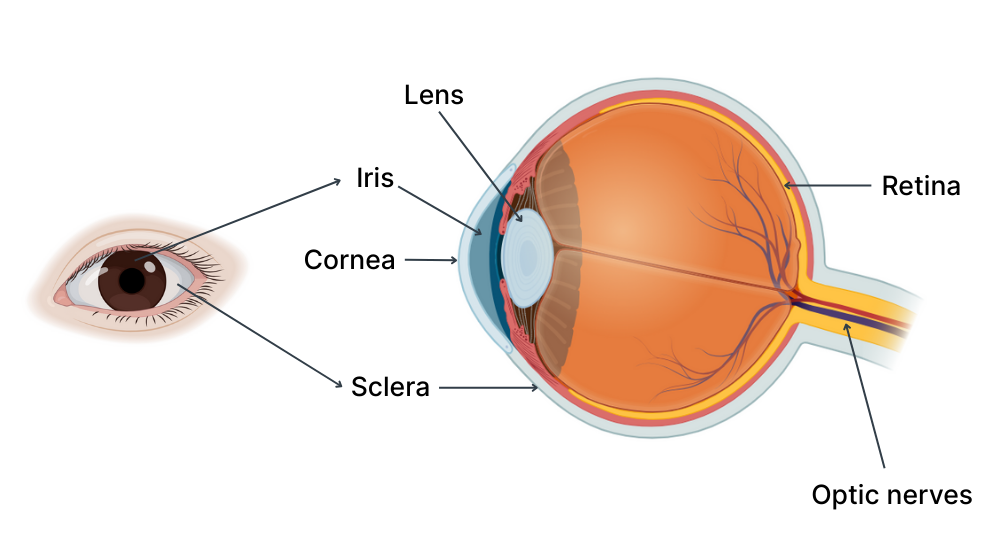Ocular neuropathic pain
Quick Search
- Summary
- Synonyms and Classifications
- Symptoms
- Disability Impacts
- Cause and Inheritance
- Diagnosis
- Treatment
- Clinical Care Team
- Clinical Care Guidelines
- Emergency Management
- Research
- Rare Disease Organisation(s)
- Lived Experience
- Support Services and Resources
- Mental Health
- Other Information
- Useful Links for Healthcare Professionals
Summary
Ocular neuropathic pain is a complex eye condition where individuals experience pain in their eyes in situations which doesn’t normally causes pain.1 The pain can range from mild to extremely painful, and can impact their quality of life.2 It is thought to be caused by damaged or oversensitive nervous system.1 Individuals with ocular neuropathic pain often do not have visible damage to the eyes and are commonly misdiagnosed as dry eye disease or dismissed by health professionals.2 Ocular neuropathic pain has been reported to affect more females than males.
Synonyms and Classifications
Synonyms: neuropathic dry eyes, neuropathic corneal pain, corneal allodynia, corneal neuropathy, corneal neuralgia, keratoneuralgia, NOP, ocular pain syndrome, phantom cornea.1,2
There is no known ORPHAcode.
Universal rare disease classifications provide a common language for recording, reporting and monitoring diseases. Please visit the Rare Disease Classifications page for more information about these internationally recognised classifications.
Symptoms
Ocular neuropathic pain varies widely between individuals.3
Individuals with ocular neuropathic pain may experience a range of dysesthesias (unpleasant abnormal sensations) in the eyes described as:1,2,4
- dryness
- burning, aching, pressure-like pain
- itching, irritation
- foreign body sensation (when it feels like something is in the eye but there is nothing physically present)
- hypersensitivity to normally painless stimulus such as light (photophobia), wind, eye drops and others
They may also experience pain or ache in areas around the eyes such as in the eyelids, cheek bones, forehead and temple.2
Ocular neuropathic pain is associated with other conditions such as autoimmune disease, chronic pain syndrome, anxiety, depression, fibromyalgia and headache.1,5
Please speak to your medical team to learn more about the symptoms and health implications of ocular neuropathic pain.
Disability Impacts
Rare diseases are often serious and progressive, exhibiting a high degree of symptom complexity, leading to significant disability. Majority of the estimated two million Australians living with a rare disease meet the Australian Government’s definition for disability (in accordance to the Australian Public Service Commission and Australian Bureau of Statistics), and many experience severe and permanent disability impacts. If you or someone you care for is experiencing disability-related impacts from a rare condition, please speak with a health or disability professional for advice. Information about relevant disability support can be found at the RARE Portal’s Disability Support Information page.
Cause and Inheritance
 Ocular neuropathic pain has been suggested to be caused by injury or dysfunction of the nerves in or around the eyes, especially corneal nerves.2,3 The cornea is the transparent layer at the front of the eyes. These nerve injuries can be caused by a wide range of reasons such as:2,3
Ocular neuropathic pain has been suggested to be caused by injury or dysfunction of the nerves in or around the eyes, especially corneal nerves.2,3 The cornea is the transparent layer at the front of the eyes. These nerve injuries can be caused by a wide range of reasons such as:2,3
- eye surgery, infection, trauma, extended contact lens wear which may lead to infection or inflammation, chemical exposure and radiation
- ocular surface diseases such as dry eye disease, blepharitis (eyelid inflammation)
- systemic conditions such as Sjogren’s syndrome, systemic lupus erythematosus (SLE), sarcoidosis, fibromyalgia, multiple sclerosis and diabetes.
Ocular neuropathic pain can also occur without any known cause.2
Diagnosis
Diagnosis of ocular neuropathic pain may be made based on:1,4
- medical history such as history of refractive or cataract surgery, ocular surface disease, infection, systemic disorders, inflammatory conditions and neurological conditions that could cause nerve injury
- ophthalmologic (eye) examination such as in vivo confocal microscope to look for corneal nerve abnormalities, and esthesiometer to measure corneal sensitivity
- questionnaires that have been developed specifically to assess eye pain
Ocular neuropathic pain is often considered a diagnosis of exclusion, which means that all other possible causes of the pain need to be ruled out.1 Doctors may do a differential diagnosis, where they rule out other conditions that have similar symptoms, such as dry eye disease.1
Please speak to your medical team to learn more about the available diagnostic pathways for this condition.
Treatment
There is currently no curative treatment for ocular neuropathic pain. Treatment is targeted at improving the function of the eye’s nerves, and reduce pain.2 This may include:1,2,4
- treatments to protect the surface of the eyes such as lubricating eye drops (artificial tears) to relieve dryness, use of sclera contact lens (that covers white part of the eyes, sclera and hold moisture in the eye surface), antibiotics to treat or prevent underlying infection
- address or remove harmful stimuli that can worsen pain
- therapies to manage nerve injuries and associated inflammation, and to support eye and nerve health
- pain management
Please speak to your medical team to learn more about the possible treatment or management options for your condition. Treatment will depend on an individual’s specific condition and symptoms. It is also important to stay connected to your medical team so that you can be made aware of any upcoming clinical trial opportunities.
Clinical Care Team
Healthcare professionals involved in the treatment of ocular neuropathic pain may include general practitioners (GP), optometrists, ophthalmologists, psychiatrists, neurologists, rheumatologists, pain specialists and others.4 The need for different healthcare professionals may change over a person’s lifetime and extend beyond those listed here.
Clinical care for rare diseases often involves a multidisciplinary team of medical, care and support professionals. Please note that the information provided here is as a guide and that RVA does not necessarily monitor or endorse specific clinics or health experts.
For many rare diseases, palliative care services may be relevant and useful. Palliative care services are available for people (adults, children and their families) living with a life-limiting illness. Palliative care services provide assistance, support, resources and tools to help people manage their illness and the symptoms, ease pain, and improve comfort and quality of life. Palliative care is not only for end-of-life care. It can also help at any stage of illness from diagnosis onwards, and will look different for different people. For more information about palliative care and how it can help you, please visit:
Clinical Care Guidelines
We are not aware of any clinical care guidelines specifically for ocular neuropathic pain in Australia. If you know of any relevant care guidelines, please let us know via the Contribute page.
Royal Australian and New Zealand College of Ophthalmologists (RANZCO): Neuro-ophthalmology Curriculum Standard (2014) has information for the diagnosis and management of neuro-ophthalmic conditions (visual problems that are related to the nervous system).
The following guidance is available from international experts outside Australia, however, there may be information that is not relevant or applicable to the Australian context, and may not be up to date:
Neuropathic Corneal Pain: Approaches for Management was developed by ophthalmologists with experience managing individuals with ocular neuropathic pain in United States; published in 2017.
Emergency Management
Individuals living with rare diseases may have complex medical issues and disabilities, which are not always visible. It is often useful to refer to their medical history as well as personal information such as a medical card, doctor’s letter, or if available, a rare disease passport, for relevant information.
NSW Government Agency for Clinical Innovation: Eye Emergency Management has information for emergency department staff for the management of common eye emergencies, which may have some relevance to the management of ocular neuropathic pain; this was published in 2023.
Research
There are specific considerations around participating in rare disease research, including clinical trials. It is important to be mindful of issues such as data privacy, research ethics, consent and differences in research regulations between Australia and other countries.
If you are interested in finding clinical trials for your condition, please visit the following websites; however, there may not be any clinical trials available:
It is best to discuss your interest in any clinical trials with your medical team to determine suitability and eligibility.
Rare Disease Organisation(s)
We are not aware of any rare disease organisations for ocular neuropathic pain in Australia or internationally. If you know of any rare disease organisation supporting people living with ocular neuropathic pain, please let us know via the Contribute page. If you are interested in starting an Australian organisation, please see Engaged, Ethical and Effective: A Guide for Rare Disease Organisation Leaders in Australia.
Please note that RVA does not monitor or endorse each group/organisation’s operational governance and activities. When engaging with a group, please consider the information on the RARE Portal’s Finding Helpful Peer and Community Supports page.
Lived Experience
Ocular neuropathic pain varies between individuals, and each person’s experience is unique.
If you would like to share your personal story with RVA, please visit the Rare Voices Australia: Share Your Story page. RVA will consider your story for publishing on our website and inclusion on the RARE Portal.
Support Services and Resources
For information on available government and social services that provide support for individuals with a rare disease, please visit the National and State Services pages.
Mental Health
People living with a rare disease, including families and carers, often face unique challenges such as diagnostic delays, misdiagnoses, limited treatment options, and limited access to rare disease specialists and support. These challenges may impact people’s emotional wellbeing and quality of life. Many people find it helpful to seek mental health and wellbeing support to cope with ongoing stress and uncertainty. Connecting with people who have shared experiences through a support group may also be helpful. Information about relevant mental health and wellbeing support can be found at:
- Mental Health and Wellbeing Support for Australians Living with a Rare Disease
- The National and State Services pages underneath the ‘Mental Health’ sections listed
Other Information
Further information on ocular neuropathic pain can be found at:
Useful Links for Healthcare Professionals
References
- Moshirfar M, Benstead EE, Sorrentino PM, et al. Ocular Neuropathic Pain. Updated 25 August 2023. In: StatPearls [Internet]. Treasure Island (FL): StatPearls Publishing; 2025 Jan-. Available from: https://www.ncbi.nlm.nih.gov/books/NBK542282/
- National Organization for Rare Disorders (NORD). Neuropathic/Nociplastic Ocular Pain. Accessed 4 August 2025. https://rarediseases.org/rare-diseases/neuropathic-ocular-pain/
- Le DTM, Kandel H, Watson SL. Evaluation of ocular neuropathic pain.
Ocul Surf. 2023;30:213-235. https://doi.org/10.1016/j.jtos.2023.09.009 - Goyal S, Hamrah P. Understanding Neuropathic Corneal Pain – Gaps and Current Therapeutic Approaches. Semin Ophthalmol. 2016;31(1-2):59–70. https://doi.org/10.3109/08820538.2015.1114853
- Watson SL, Le DTM. Corneal neuropathic pain: a review to inform clinical practice. Eye. 2024;38:2350–2358. https://doi.org/10.1038/s41433-024-03060-x
Contributors
This page has been developed by Rare Voices Australia (RVA)’s RARE Portal team.
If you are aware of any additional information that may benefit stakeholders with an interest in this page, or if you notice any broken links or inaccurate information, please let us know via the Contribute page.

